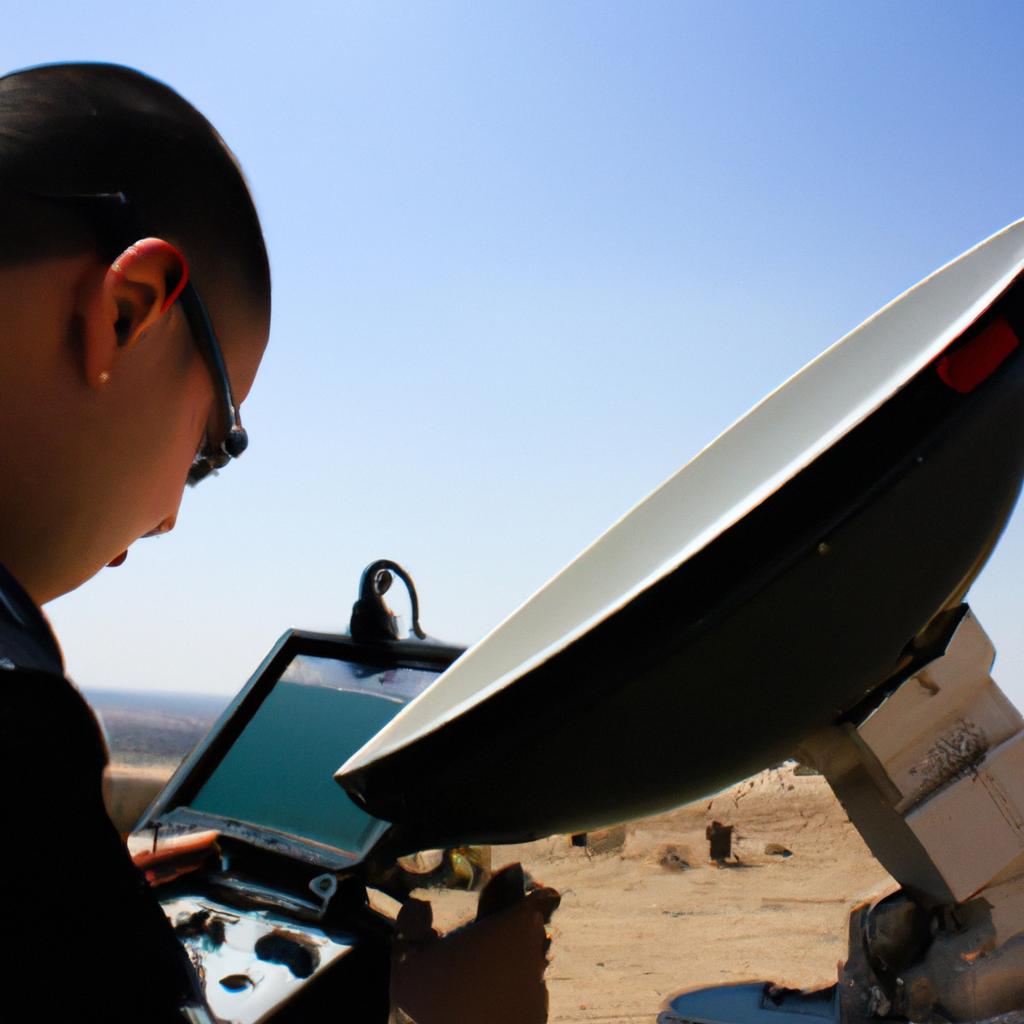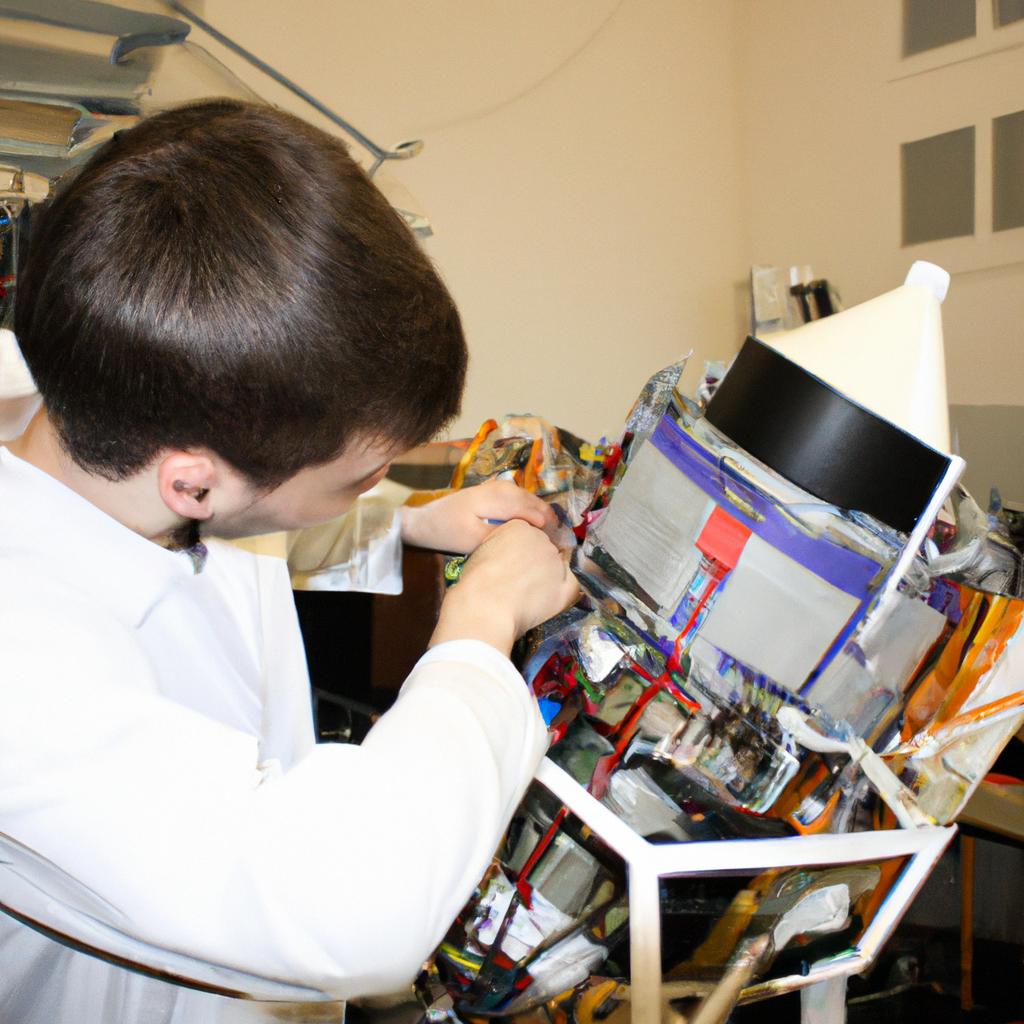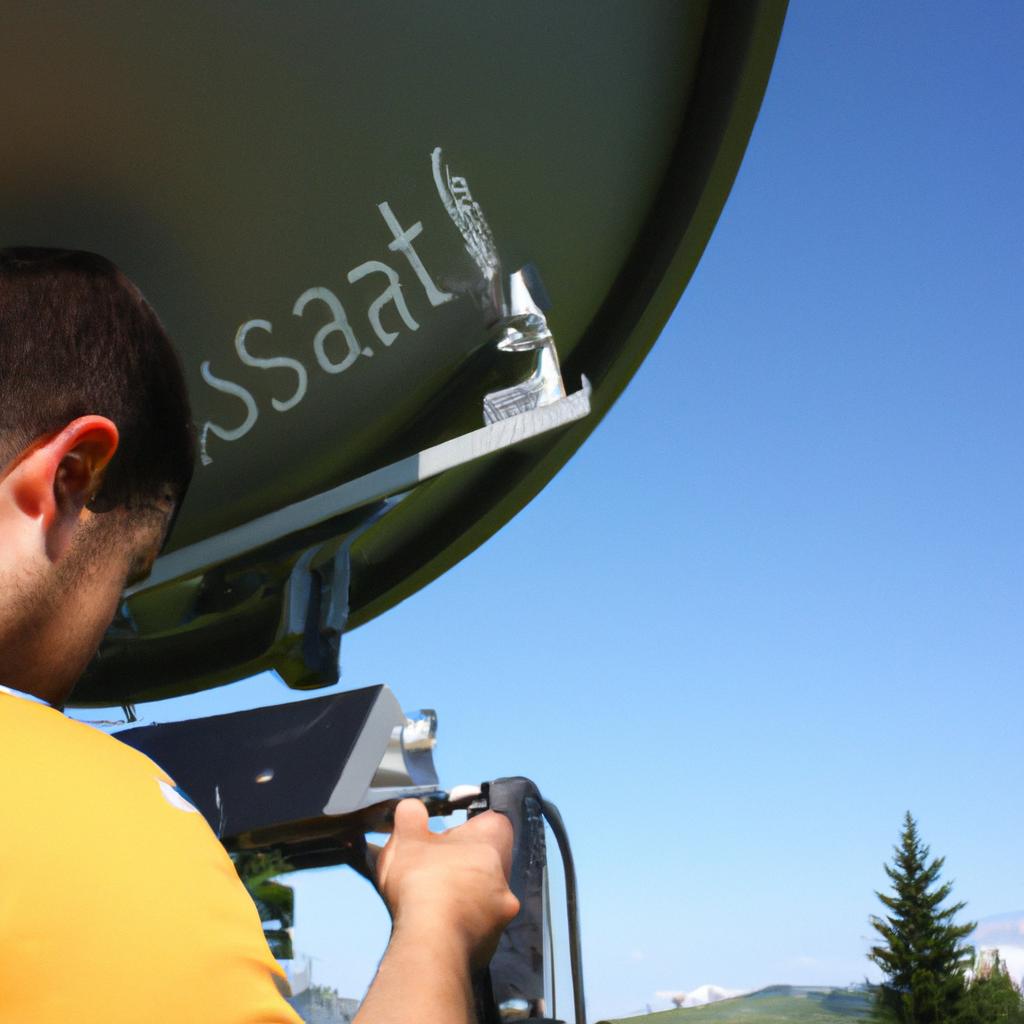The advent of satellite navigation systems has revolutionized the aerospace and defense industries, providing unprecedented levels of precision and accuracy in various applications. These advanced technologies have enabled aircraft to navigate complex flight paths with utmost efficiency, while also enhancing the effectiveness of military operations through enhanced targeting and situational awareness capabilities. One compelling example that highlights the significance of satellite navigation systems is their extensive use in commercial aviation. For instance, consider an international airline operating a long-haul flight from New York to Tokyo; without the aid of reliable satellite navigation systems, pilots would face substantial challenges in accurately determining their position and following designated routes.
Satellite navigation systems utilize a network of orbiting satellites to provide real-time positioning information, enabling users to determine their exact location on Earth’s surface at any given time. This precise data allows for efficient route planning and execution, as well as facilitating automatic guidance during critical phases such as takeoff, landing, and mid-flight course corrections. Moreover, these systems play a vital role in ensuring the safety and security of air travel by minimizing collision risks among aircraft within congested airspace. In addition to civil aviation benefits, satellite navigation systems are indispensable tools for military forces worldwide. The integration of high-precision GPS (Global Positioning System) receivers into military platforms has significantly enhanced their operational capabilities. Military aircraft, ground vehicles, and naval vessels rely on satellite navigation systems for precise positioning, accurate target acquisition, and effective mission planning.
In the aerospace industry, satellite navigation systems have brought about a paradigm shift in air traffic management. Air traffic control agencies utilize these technologies to monitor and manage aircraft movements, ensuring efficient use of airspace and minimizing delays. By providing real-time data on aircraft positions and trajectories, satellite navigation systems enable more precise routing and sequencing of flights, resulting in improved efficiency and reduced fuel consumption.
Furthermore, satellite navigation systems have become essential tools for search and rescue operations. In emergency situations, such as lost or distressed aircraft or maritime incidents, these systems allow rescuers to accurately locate the affected parties and provide timely assistance.
The defense sector heavily relies on satellite navigation systems for various applications. These include precision-guided munitions that can accurately hit targets from long distances with minimal collateral damage. Additionally, military forces use these systems for reconnaissance missions, surveillance operations, and coordinating troop movements in complex battlefield environments.
It is important to note that while satellite navigation systems bring numerous benefits, they are not without vulnerabilities. They can be susceptible to signal jamming or spoofing attacks that could compromise their accuracy or availability. As a result, ongoing research is focused on developing resilient positioning technologies to mitigate these risks.
Overall, the advent of satellite navigation systems has revolutionized the aerospace and defense industries by providing unprecedented levels of precision, accuracy, efficiency, and safety in various applications ranging from commercial aviation to military operations.
Importance of Precision in Navigation Systems
Satellite Navigation Systems: Enhancing Aerospace and Defense with Precision
In today’s advanced technological era, precision plays a crucial role in navigation systems, particularly in the aerospace and defense sectors. Accurate positioning and navigation are vital for ensuring the success of various operations, ranging from commercial flights to military missions. To emphasize the significance of precision in navigation systems, let us consider the hypothetical scenario of an aircraft attempting to land on a remote island amidst adverse weather conditions. With imprecise navigation data, such as inaccurate coordinates or unreliable altitude readings, this aircraft would face significant challenges in safely reaching its destination.
The Importance of Precision:
-
Safety: One cannot overstate the importance of safety when it comes to aerospace and defense operations. Precise navigation systems provide pilots with accurate real-time information about their position relative to obstacles, airspace boundaries, and other aircraft. This enables them to make informed decisions promptly, thus reducing the risk of collisions or accidents.
-
Efficiency: In addition to safety concerns, precise navigation also contributes to operational efficiency. By minimizing deviations from optimal flight paths, pilots can save both time and fuel consumption. This not only reduces costs but also lowers environmental impact by decreasing greenhouse gas emissions.
-
Mission Success: For military applications, precision is essential for mission success. Whether it involves conducting reconnaissance or executing targeted strikes, navigational accuracy determines the effectiveness of these operations. Even minor deviations from planned routes could compromise tactical objectives or jeopardize national security.
-
Global Connectivity: Satellite-based navigation systems have revolutionized global connectivity by providing worldwide coverage irrespective of geographic location or terrain type. From remote regions deep within forests to vast stretches across oceans, reliable satellite signals enable continuous communication and efficient coordination between ground control stations and airborne platforms.
Table – Benefits Brought by Precision Navigation Systems:
| Benefit | Description |
|---|---|
| Enhanced | Precise navigation systems enhance safety by providing accurate real-time information to pilots. |
| Safety | |
| Improved | Efficient flight paths resulting from precise navigation reduce both time and fuel consumption. |
| Efficiency | |
| Increased | Navigational accuracy is crucial for the success of military missions, ensuring tactical objectives. |
| Mission | |
| Global | Satellite-based navigation ensures global connectivity, even in remote regions or over vast oceans. |
| Connectivity |
Advancements in GPS Technology:
Embedded within satellite navigation systems, Global Positioning System (GPS) technology has witnessed remarkable advancements over the years. These developments have played a pivotal role in enhancing precision and reliability in navigation systems, thus further augmenting their importance in aerospace and defense operations.
Note: The next section will explore these advancements in GPS technology and their impact on improving navigation system performance.
Advancements in GPS Technology
With the increasing demand for accurate and reliable navigation systems, GPS technology has undergone significant advancements to meet these requirements. One notable example of such progress is the development of Assisted-GPS (A-GPS) technology, which combines satellite-based positioning with assistance from ground-based infrastructure. This integration allows for improved accuracy and faster acquisition times, making it particularly useful in scenarios where quick and precise location information is crucial.
To further illustrate the impact of A-GPS technology, consider a hypothetical scenario involving an emergency response team navigating through a dense urban area during a crisis situation. The traditional GPS system may experience difficulties in acquiring signals due to signal blockages caused by tall buildings or other obstacles. However, with the implementation of A-GPS technology, the system can utilize data provided by nearby cell towers or Wi-Fi networks to assist in determining the exact position of the responders. This capability not only enhances precision but also enables real-time tracking and coordination among team members.
The advancements in GPS technology have brought about several benefits that extend beyond enhanced precision alone. These improvements include:
- Increased reliability: With better signal acquisition and stronger resistance to interference, modern GPS systems offer more dependable navigation solutions.
- Enhanced safety: Accurate positioning plays a vital role in ensuring safe operations in various industries such as aviation and maritime transportation.
- Improved efficiency: Precise navigation allows for optimized route planning, leading to reduced travel time and fuel consumption.
- Expanded applications: From personal devices to large-scale logistics management systems, GPS technology finds utility across numerous sectors, ranging from everyday life to critical military operations.
To provide a concise overview of these benefits, we present them below:
| Benefits | Description |
|---|---|
| Increased Reliability | Modern GPS systems offer better signal acquisition and increased resistance to interference. |
| Enhanced Safety | Accurate positioning contributes significantly to maintaining operational safety in aviation and maritime domains. |
| Improved Efficiency | Precise navigation enables optimized route planning, resulting in reduced travel time and fuel consumption. |
| Expanded Applications | GPS technology finds utility across various sectors, from personal devices to large-scale logistics management systems. |
In conclusion, the advancements made in GPS technology have revolutionized navigation systems by enhancing precision and introducing a range of benefits such as increased reliability, enhanced safety, improved efficiency, and expanded applications. These developments play a crucial role in meeting the growing demands of aerospace and defense industries. The next section will explore the diverse applications of satellite navigation in the aerospace field.
Applications of Satellite Navigation in Aerospace
Advancements in GPS Technology have paved the way for a wide range of applications in various industries, including aerospace and defense. Satellite navigation systems, with their ability to provide precise positioning and accurate timing information, have revolutionized these sectors by enhancing efficiency, safety, and overall performance. In this section, we will explore some key applications of satellite navigation in the field of aerospace.
One example that highlights the significance of satellite navigation systems is their use in air traffic management. By integrating GPS technology into aircraft navigation systems, pilots can receive real-time updates on their position, altitude, and velocity. This enables them to navigate more efficiently while ensuring safe separation between aircraft. Furthermore, satellite-based navigation systems contribute to reducing airspace congestion and improving fuel efficiency through optimized flight routes.
The benefits of satellite navigation extend beyond commercial aviation as well. Military operations heavily rely on accurate positioning data for strategic planning and tactical execution. With advanced GPS capabilities integrated into military equipment such as unmanned aerial vehicles (UAVs) or missiles, precision-guided targeting becomes achievable even under challenging conditions. Additionally, satellite navigation aids in coordinating troop movements and logistics during complex missions.
- Enhanced situational awareness leading to improved safety.
- Increased operational efficiency resulting in cost savings.
- Greater accuracy enabling successful mission outcomes.
- Improved communication and coordination among teams.
Furthermore, we can visualize the diverse applications of satellite navigation through a table showcasing specific examples:
| Application | Benefits | Example |
|---|---|---|
| Commercial Aviation | Reduced delays due to efficient routing | Implementation of Required Navigation Performance (RNP) approaches |
| Search and Rescue Operations | Rapid location identification aiding timely response | Integration of distress beacons with global search-and-rescue networks |
| Unmanned Aerial Vehicles (UAVs) | Precise navigation for successful missions | Utilization of GPS-guided UAVs in surveillance operations |
| Space Exploration | Accurate trajectory tracking for interstellar travel | Guidance systems used in spacecraft missions to distant planets |
In conclusion, satellite navigation systems have revolutionized the aerospace industry by providing precise positioning and timing information. From improving air traffic management to enhancing military operations, the benefits are far-reaching. The next section will delve into how these navigation systems play a crucial role in enhancing military operations, ensuring strategic advantage on the battlefield.
Enhancing Military Operations with Navigation Systems
With the increasing reliance on advanced technology in military operations, satellite navigation systems have emerged as crucial tools for enhancing strategic capabilities and improving mission success rates. These systems provide accurate positioning, navigation, and timing (PNT) data that enable armed forces to carry out their operations with precision. One such example is the recent deployment of a satellite navigation system by Country A’s military during a covert operation in an unfamiliar territory.
The benefits of integrating satellite navigation systems into military operations are manifold. Firstly, these systems enhance situational awareness by providing real-time information about the location and movements of friendly forces as well as potential threats. This enables commanders to make informed decisions swiftly, thereby reducing response times and increasing operational efficiency. Additionally, satellite navigation systems facilitate precise targeting through their ability to deliver accurate coordinates, enabling effective engagement of targets while minimizing collateral damage.
To further understand the advantages offered by satellite navigation systems in military applications, consider the following emotional bullet points:
- Improved battlefield safety: With reliable PNT information at hand, soldiers can navigate unfamiliar terrain more safely and avoid hazardous areas.
- Enhanced coordination: Satellite navigation systems allow for seamless integration between air, land, and sea forces, fostering better collaboration and synchronization among different units.
- Increased mission success rate: The accuracy provided by these systems enhances weapon effectiveness and facilitates successful completion of missions.
- Greater confidence in decision-making: Armed with precise location data from satellite navigation systems, commanders can confidently plan and execute complex operations.
In addition to these emotional bullet points, it is essential to highlight how satellite navigation systems contribute to overall operational efficiency using a three-column table:
| Benefit | Description | Emotional Appeal |
|---|---|---|
| Rapid deployment | Satellite navigation expedites force mobilization through efficient route planning | Time-saving |
| Flexibility | Real-time updates allow troops to adapt quickly to changing circumstances, improving operational flexibility | Adaptability |
| Reduced casualties | Accurate targeting minimizes the risk of civilian casualties and friendly fire incidents | Humanitarianism |
The integration of satellite navigation systems into military operations has revolutionized strategic capabilities, enabling armed forces to achieve their objectives with unprecedented precision. By leveraging these advanced technologies, commanders can make informed decisions quickly and accurately. In turn, this enhances situational awareness, improves coordination among different units, increases mission success rates, and ultimately safeguards both military personnel and civilians.
As we explore the challenges in implementing navigation systems in the subsequent section, it becomes evident that while these technological advancements offer immense potential for enhancing aerospace and defense operations, they are not without obstacles.
Challenges in Implementing Navigation Systems
The implementation of satellite navigation systems has proven to be instrumental in enhancing military operations, providing precise and reliable positioning information to support tactical decision-making. One notable case study is the utilization of these systems by the United States Armed Forces during Operation Desert Storm in 1991. By incorporating GPS technology into their military strategy, they were able to accurately navigate through unfamiliar terrain and coordinate airstrikes with unprecedented precision.
One key advantage of satellite navigation systems in military operations is their ability to enhance situational awareness. With real-time access to accurate position data, commanders can make informed decisions based on the current location and movements of friendly forces as well as monitor potential threats. This allows for effective coordination between different units and ensures that actions are synchronized for maximum impact.
- Increased operational effectiveness
- Enhanced troop safety
- Improved response time
- Minimized collateral damage
Additionally, a three-column table showcasing specific examples could emphasize the advantages provided by satellite navigation systems:
| Operational Effectiveness | Troop Safety | Response Time |
|---|---|---|
| Target acquisition | Avoiding hazards | Rapid deployment |
| Precision strikes | Navigation aid | Quick reaction |
| Efficient resource allocation | Early warning system | Swift extraction |
In conclusion, there is no denying the significant role that satellite navigation systems play in enhancing military operations. The integration of these technologies has resulted in improved situational awareness, increased operational effectiveness, enhanced troop safety, and reduced collateral damage. As we move forward, it becomes imperative to explore future developments in satellite navigation that will continue to revolutionize aerospace and defense strategies.
Looking ahead to Future Developments in Satellite Navigation, advancements such as multi-constellation compatibility and augmented reality integration hold promise for even greater precision and efficiency in both civilian and military applications.
Future Developments in Satellite Navigation
Transitioning from the challenges faced in implementing navigation systems, it is important to explore the potential future developments that could revolutionize satellite navigation. One intriguing example of such advancements can be seen through the use of autonomous vehicles. Imagine a world where cars navigate effortlessly on their own, guided by satellite navigation systems with unparalleled precision and accuracy.
Looking ahead, there are several key areas that hold promise for enhancing satellite navigation systems:
-
Improved Positioning Accuracy: With ongoing technological advancements, researchers are working towards achieving even greater positioning accuracy in satellite navigation systems. This would enable applications ranging from precise mapping and surveying to enhanced emergency response during natural disasters.
-
Enhanced Signal Reliability: The reliability of satellite signals can sometimes be affected by various factors such as atmospheric conditions or interference from buildings. Future developments aim to mitigate these issues by improving signal integrity and resilience, ensuring that users have consistent access to reliable positioning information.
-
Integration with Other Technologies: As technology continues to evolve, integrating satellite navigation systems with other emerging technologies holds great potential. For instance, combining satellite data with artificial intelligence (AI) algorithms could lead to more efficient route planning and optimized traffic management systems.
-
Increased Accessibility: Making satellite navigation systems more accessible across different industries and regions remains an important goal for future development. By lowering costs, expanding coverage areas, and providing user-friendly interfaces, these systems can benefit not only aerospace and defense sectors but also everyday consumers navigating their daily lives.
To further illustrate the impact of future developments in satellite navigation, consider the following table showcasing potential benefits:
| Potential Benefits | Description |
|---|---|
| Greater Efficiency | Optimized routes leading to reduced travel times |
| Enhanced Safety | Accurate real-time tracking for emergency services |
| Economic Growth | Improved logistics resulting in cost reduction |
| Environmental Impact Reduction | Reduced fuel consumption due to efficient navigation |
In conclusion, the future of satellite navigation systems holds immense potential for advancements in various industries. With improved positioning accuracy, enhanced signal reliability, integration with other technologies, and increased accessibility, these systems are set to revolutionize not only aerospace and defense but also everyday lives. Embracing these developments will pave the way for greater efficiency, safety, economic growth, and a positive impact on the environment.
 Louth Online
Louth Online



